Resonant Homoclinic Flips Bifurcation in Principal Eigendirections
Abstract
A codimension-4 homoclinic bifurcation with one orbit flip and one inclination flip at principal eigenvalue direction resonance is considered. By introducing a local active coordinate system in some small neighborhood of homoclinic orbit, we get the Poincaré return map and the bifurcation equation. A detailed investigation produces the number and the existence of 1-homoclinic orbit, 1-periodic orbit, and double 1-periodic orbits. We also locate their bifurcation surfaces in certain regions.
1. Introduction and Hypotheses
The study of homoclinic flip bifurcations is comprehensively developed from the last two decades with the beginning work of Yanagida (1987) for homoclinic-doubling bifurcations. Generally there exist two kinds of homoclinic flips, namely the orbit flips and the inclination flips corresponding to nonprincipal homoclinic orbits or critically twisted homoclinic orbits, respectively. Kisaka et al. in [1, 2] and Naudot in [3] studied some cases of codimension two inclination flips; Morales and Pacifico in [4] and Naudot in [5] considered the orbit flips cases, while Homburg and Krauskopf in [6] proposed several unfoldings of the resonant homoclinic flip bifurcations around the central codimension-three point (the organizing centre) in parameter space to study the qualitative structure of bifurcation curves on a sphere and also that of Oldeman et al. in [7] by a numerical investigation with some software into these bifurcations in a specific three-dimensional vector field.
Recently, Zhang et al. in [8–10] studied a kind of multiple flips homoclinic resonant bifurcation and got the existence of some saddle-node bifurcations and homoclinic-doubling bifurcations. Meanwhile Geng et al. in [11], Lu et al. in [12], and Liu in [13] discussed, respectively, a heterodimensional cycle flip or accompanied by transcritical bifurcation; they found the double and triple periodic orbit bifurcations and gave also some coexistence conditions for homoclinic orbits and periodic orbits.
As mentioned in [6, 7], due to the break of three genericity conditions, there are many complicated homoclinic flips cases to study. In this paper, we confine our attention to a principal eigenvalue resonance of one orbit flip and one inclination flip homoclinic bifurcation. Compared with the above-mentioned work, our subject is very challenging and difficult because of the stronger degeneracy and the higher codimension. By constructing specifically a local active coordinate in a small tubular neighborhood of homoclinic orbit, we establish a regular map and then combine it with a singular map defined by the approximation solutions of system to build Poincaré return map (see also [14]). We obtain the existence of several 1-periodic orbit, 1-homoclinic orbit, and double 1-periodic orbits, as well as some bifurcation surfaces with the analysis of the bifurcation equation.
-
(H1) Resonance. λ1(μ) = ρ1(μ), |μ | ≪ 1, where λ1(0) = λ1 and ρ1(0) = ρ1.
-
(H2) Orbit Flip. Define ; ; then e+ ∈ T0Wu and are unit eigenvectors corresponding to λ1 and −ρ2, respectively, where T0Wu (resp., T0Wss) is the tangent space of the corresponding manifold Wu (resp., Wss) at the saddle z = O.
-
(H3) Inclination Flip. Let and e− be the unit eigenvectors corresponding to λ2 and −ρ1, respectively, and
()
Remark 1. Hypothesis (H2) is called an orbit flip because homoclinic orbit trends from the weak unstable manifold toward the strong stable manifold. Hypothesis (H3) means an inclination flip for its equivalence to
2. Poincaré Return Map
This section treats mainly the establishment of Poincaré return map with two steps. To begin we first need to transform system (1) into a normal form in some neighborhood of the origin O.
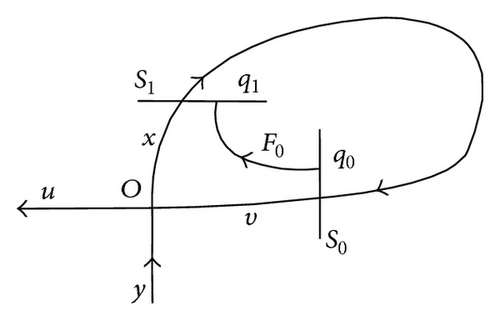
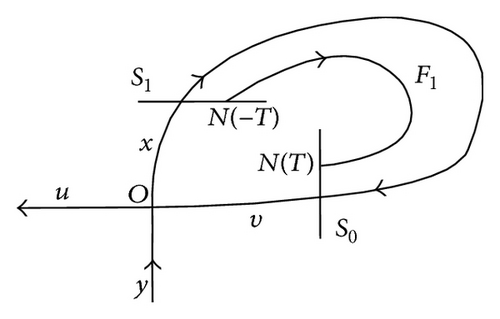
Lemma 2. There exists a fundamental solution matrix Z(t) = (z1(t), z2(t), z3(t), z4(t)) of system (8) satisfying
Proof. Notice that the tangent subspace Tγ(−T)Wu is invariant and is straightened to be u axis; it is possible to choose z3(−T) = (0,0, 1,0) since z3(t) ∈ Tγ(t)Wu. While for w31 ≠ 0, it is because and z3(T) ∈ Tγ(T)Wu corresponding to x axis.
As to zi(−T) or zi(T), i = 1,2, 4, one may refer to [8, 9] for the similar proof, but we omit the details here.
Remark 3. The matrix (Z−1(t)) * is a fundamental solution matrix of system (9). We denote it as Φ(t) = (ϕ1(t), ϕ2(t), ϕ3(t), ϕ4(t)) = (Z−1(t)) *; then ϕ1(t)∈(Tr(t)Wu) c∩(Tr(t)Ws) c is bounded and tends to zero exponentially as |t | →+∞ due to <ϕi(t), zi(t) ≥ 1 and zi(t) tends exponentially to infinity.
Equation (14) defines exactly the map F1 : S1 → S0; N(−T) ↦ N(T) under the new coordinate system; see Figure 1(b).
3. Bifurcation Results
From the definition of the Silnikov time , we know that a solution with s > 0 of (16) or equivalently τ > 0 corresponds to a periodic orbit near Γ and a solution with s = 0 of (16) or equivalently τ = +∞ corresponds to a homoclinic orbit near Γ. It is enough to study the solutions of the successor function G(s, u1, y0) = 0 for bifurcation analysis. Consider for concision that we omit the dependence on parameter μ from now on in the exponent notation.
Theorem 4. Suppose that M1 ≠ 0 and w33 ≠ 0 are true; then system (1) has a unique 1-periodic orbit near Γ for w31w33M1μ < 0 or has a unique 1-homoclinic orbit Γμ near Γ as , and they do not coexist.
Proof. Clearly F(s, μ) = 0 has a small positive solution ., for w31w33M1μ < 0, and has a zero solution s = 0 for μ ∈ H1 which is a codimension-one hypersurface.
Then there are firstly the following conclusions based on an analysis of the relative position of the line W = P(s, μ) and the curve W = Q(s, μ).
Lemma 5. Suppose that 2λ1 > λ2 > ρ2, w33 = 0, and w42 ≠ 0 hold; then F(s, μ) = 0 has a unique small positive solution for , where .
Proof. It is clear that
Theorem 6. Suppose that 2λ1 > λ2 > ρ2, w33 = 0, and w42 ≠ 0 hold; then system (1) has exactly a unique (resp., not any) 1-periodic orbit for (resp., ).
Proof. From Lemma 5, we know that F(s, μ) = 0 has exactly a unique small positive solution for which corresponds exactly to a 1-periodic orbit of system (1). Moreover, F(s, μ) = 0 does not have any small positive solutions for .
Theorem 7. Suppose that 2λ1 > λ2 > ρ2, w33 = 0, and w42 ≠ 0 hold; then, for and Rank (M1, M4) = 2, system (1) has a unique double 1-periodic orbit near Γ on the bifurcation surface
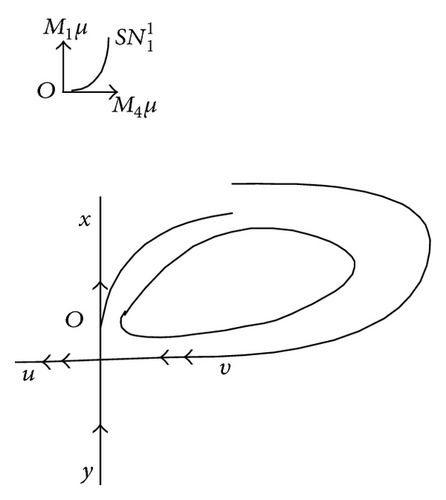
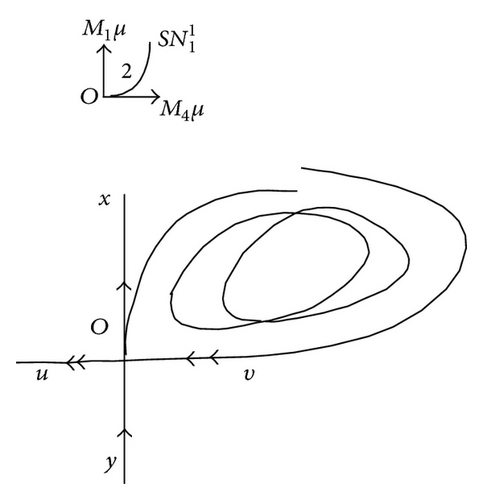
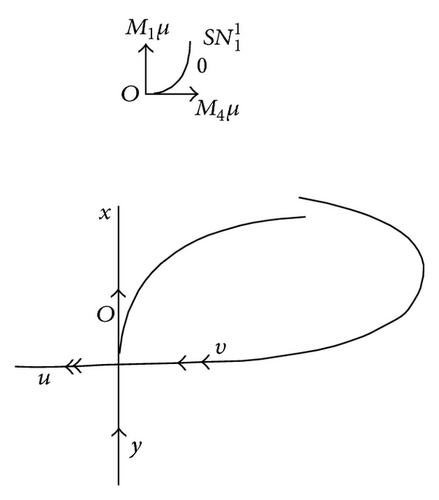
Proof. We know that the existence of a double 1-periodic orbit corresponds to the equations P(s, μ) = Q(s, μ), P′(s, μ) = Q′(s, μ), and P′′(s, μ) ≠ Q′′(s, μ), that is,
From the above proof, we see that, when M4μ > 0 and w12M1μ < 0, the line W = P(s, μ) has a positive slope lying under the curve W = Q(s, μ) when w42w44 > 0, so if w12M1μ increases, the line must intersect the curve at two sufficiently small positive points, which can be equal to the existence of two 1-periodic orbits of system (1). For M4μ < 0, w42w44 < 0, and w12M1μ > 0, the arguments are similar. So we have immediately a complement of Theorem 7.
Corollary 8. Assume that the hypotheses of Theorem 7 are valid, system (1) then has two (resp., not any) 1-periodic orbits near Γ when μ lies on the side of SN1 which points to the direction (sgn w12w42w44) M1 (resp., in the opposite direction) (see Figures 2(b) and 2(c)).
As Melnikov functions generally play an important role in bifurcation study, the following theorem shows also the existence of some double 1-periodic orbits relying on the investigation of Mi = 0 for i = 1,3, 4.
Theorem 9. Suppose 2λ1 > λ2 > ρ2, w33 = 0, and w42 ≠ 0 are valid; then the following applies.
- (1)
For M1 = 0 or , system (1) has exactly one 1-homoclinic orbit and one (resp., not any) 1-periodic orbit near Γ and they (resp., do not) coexist as (resp., ).
- (2)
For M3 = 0, system (1) has exactly one (resp., not any) 1-periodic orbit near Γ as (resp., ).
-
system (1) has a unique double 1-periodic orbit near Γ as and Rank (M1, M4) = 2. Accordingly, the double 1-periodic orbit bifurcation surface is with a normal vector M1 at μ = 0, and it may generate two 1-periodic orbits when μ lies in the direction (sgn w42w44w12)M1 of SN1 and no such a 1-periodic orbit in the opposite direction.
- (3)
For M4 = 0 or , system (1) has only one (resp. not any) 1-periodic orbit near Γ as (resp., ).
- (4)
For , system (1) does not have any 1-periodic orbit near Γ.
- (5)
For , system (1) has only one 1-homoclinic orbit near Γ.
Proof. When M1 = 0 or M1 = M3 = 0, has two solutions s1 = 0 and . for which correspond to a 1-periodic orbit, and a 1-homoclinic orbit respectively. Thus, (1) is true.
The result of the cases (2) is exactly the same as that of Theorem 7.
If M4 = 0 or M3 = M4 = 0, F(s, μ) = 0 has only a positive solution . for , which means system (1) has a 1-periodic orbit. Then (3) is valid.
In case of , it is clear that F(s, μ) = 0 does not have any small nonnegative solutions, so system (1) does not have, any 1-homoclinic orbits or 1-periodic orbits.
The last conclusion is obvious. Thereby, the proof is complete.
Remark 10. Notice that, in Theorem 9 (1) and (5), F(s, μ) = 0 has a solution s = 0, which means that system (1) has a codimension-1 1-homoclinic orbit (see Figure 3(a)), so the existing homoclinic orbit is no longer orbit flip for y0 = M4μ + h.o.t.≠0. But if y0 = 0, an orbit flip homoclinic orbit could still exist, where y0 is given by G4 = 0; see Figure 3(b).
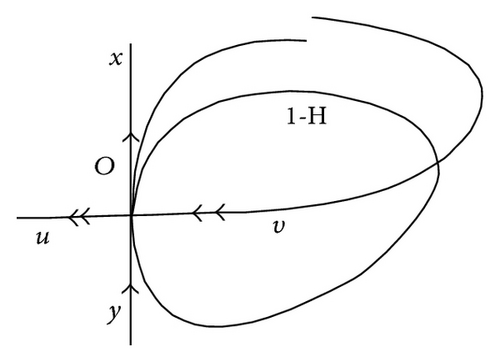

Remark 11. There still exist some double 1-periodic orbits or triple 1-periodic orbits for the case w42 = 0 and δu ≠ 0; one may pursue the similar process to discuss, so we leave it here.
Acknowledgment
The project is supported by the National Natural Science Foundation of China (no. 11126097).




